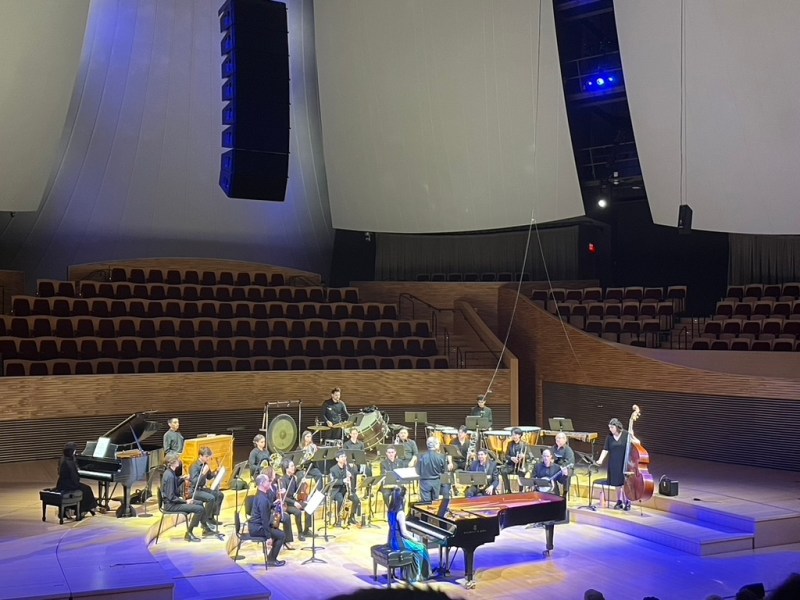Editor’s Note: This article is a review and includes subjective opinions, thoughts and critiques.
It’s not everyday that a live audience is invited to contribute to a world class jazz performance. But this is exactly what conductor and NPR columnist Rob Kapilow requested during the most recent installment of his “What Makes It Great” live series. His Thursday performance at Bing Concert Hall focused on George Gershwin’s “Rhapsody in Blue.” Kapilow’s expertise and passion dazzled in combination with the vibrance of piano soloist and Keyboard Studies Director Elizabeth Schumann and the accompanying jazz ensemble, making for a night of musical magic and fanfare.
Kapilow, an award-winning composer, musician and commentator, explained at the show’s start that the night would be divided into three segments. First, he would spend 60 minutes breaking down “Rhapsody in Blue,” explaining the musical significance of different themes and passages to give the audience a better understanding of the piece’s construction and “what makes it great.”
Following an intermission, Schumann and the jazz ensemble – made up of the Stanford Jazz Orchestra and guest musicians – performed the piece in its entirety, which the audience would hopefully appreciate with heightened perspective. Finally, a Q&A session occured, where audience members could ask questions to any performer.
According to Kapilow, the now-iconic jazz composition, “Rhapsody in Blue,” was initially met with mixed reviews when it was released in 1924 by classical critics, who were perplexed by the piece’s novelty and “lack of form.”
Challenging this, Kapilow pointed out the piece’s form across its five distinguishable themes — the ritornello, the stride, the train, the shuffle and the love theme. The demonstration felt like an engaging class lecture: Kapilow spoke with infectious enthusiasm and comedic timing that regularly made the audience laugh or applaud.
His explanations were both digestible and insightful. He frequently tapped out melodies on his keyboard and cued the band to demonstrate examples of “blues notes,” melodic transpositions and chromatic scales.
Kapilow walked the audience through “Rhapsody in Blue” so fluidly that his 60-minute breakdown of the piece flew by. At times he had the crowd join in, asking them to clap to triplet rhythms (notes that divide one beat into three) or sing along to the piano’s melody during the “Man I Love” theme. In the second half of the performance, when the ensemble played the band piece in full, you could hear every nuance Kapilow had brought up, and Gershwin’s aspirations for the composition seemed to radiate throughout the concert hall.
In most present-day symphonic performances of “Rhapsody in Blue,” according to Kapilow, the orchestra maintains a classical style while a solo pianist is in charge of the jazz rhythm. However, Kapilow said that his arrangement of the classic was “something almost no one has ever heard.” The conductor chose to stay as true to Gershwin’s original vision as possible: the band played the jazz rhythm, while pianist Schumann played more classically. Percussionist Gunnar Hanson ’25 even played the drums with a brush in one hand and a flyswatter in the other, as was noted in Gershwin’s original score.
From the iconic opening clarinet glissando, played masterfully by 17-year-old Nathan Tokunaga, to the bright, crisp violin cadenzas and the “flutter-tongued,” crooning trumpets, “Rhapsody in Blue” was a celebration of joyful music from start to finish. Schumann’s expert cross-handed piano melodies also shined, as she wowed the audience with her technique and confident playing. Kapilow spoke about how the piece, at its core, is built on the motif of “transforming the characters of the five main themes,” and this was evident through the winding movements and dynamic range of the performance.
Schumann brought her own artistic spirit to her rendition of “Rhapsody in Blue.” The pianist played with bold, sweeping expression and delicate attention to detail. During the Q&A portion of the night, she revealed that she had first heard the piece when she was in the eighth grade and became “obsessed” — though Thursday night was her very first time ever performing it.
Even more impressive was the fact that the entire ensemble, including Schumann, had only first met Kapilow on Wednesday night preceding their performance. The group had played the piece in full just once before the concert. Kapilow credited their immediate chemistry to the excellence of every individual performer, citing that years of experience made it easy to learn the piece in such a short time.
In many ways, “Rhapsody in Blue” was an experiment by Gershwin and pushed the boundaries of classical jazz at the time of its debut — what other jazz compositions called for a banjo and a gong in the same piece? And yet its popularity spread like wildfire and continues to be regarded as a defining piece of the Jazz Age. Kapilow mused on the piece’s significance, noting that its novelty and innovative nature highlight “the privilege of being who you are” and the wonderful art that emerges when one lets go of their expectations.
